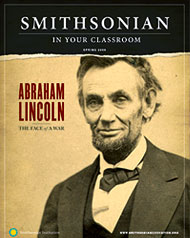|
|
 |
 |
 |
|
Getting Started |
 |
 |
 |
 |

The face of Abraham Lincoln is so much with us, from Mount Rushmore to the penny, that it is easy to overlook anything human in it. Before we see wisdom, compassion, humor, sorrow, or any other quality, we see a symbol, as familiar in its outlines as the Statue of Liberty. Lincoln was a symbol in his own time—of the Union or emancipation or tyranny —but he was still a man, not yet a monument. Physically, he was a figure of fun, as much to himself as to others. Once when he was accused of being “two-faced,” he replied, “If I had two faces, would I be wearing this one?”
In the first lesson in this issue, students take a close look at Lincoln the man, as seen in two photographs, taken in 1860 and 1865, and in two plaster “life masks,” made in the same years. This exercise in portrait analysis leads to a study of events in the years between—years that changed Lincoln drastically—and might serve as an introduction to a unit on the Civil War.
In the second lesson, students examine an eyewitness drawing of Lincoln’s arrival in the enemy capital of Richmond, Virginia, at the end of the war. As he moved among former slaves, Lincoln the person became freedom’s personification. Never before had an appearance by a president—the mere showing of his face—meant more to his audience.
|
 |
 |
 |
 |

Smithsonian in Your Classroom is produced by the Smithsonian Center for Education and Museum Studies. Teachers may duplicate the materials for educational purposes.
|
 |
 |
 |
|
|
|

